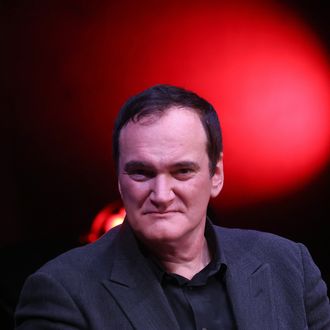
Quentin Tarantino backed himself into a bit of a corner. For years, the filmmaker has suggested he would retire after ten movies, arguing that he’d rather exit the stage with an undeniable mic drop than end up like one of his heroes, Don Siegel, who made two poorly received films after his late-career peak of 1979’s Escape From Alcatraz. Of course, Tarantino could easily change his mind (he wouldn’t be the first filmmaker to unretire), but ever since the release of his ninth and supposedly penultimate movie, 2019’s Once Upon a Time in Hollywood …, he’s seemed intent on exploring what a post-filmmaking career might look like. First, he wrote a novelization of OUATIH, which was a fun but low-stakes exercise in pulpy prose writing that expanded the world of the movie. He then launched The Video Archives Podcast, in which he and Pulp Fiction co-writer Roger Avary discuss movies they might’ve recommended to customers back when they worked together at the Video Archives store in Manhattan Beach.
Now, he’s made his long-promised pivot to writing about film. Cinema Speculation is a collection of essays organized around American films released between 1968 and 1981, touching on the intersecting movements therein, including the New Hollywood and Blaxploitation. Blending together criticism, historical analysis, and Tarantino’s own origin story, the book is an informative but self-indulgent journey through the past, in which the author makes characteristically idiosyncratic arguments, acts as a hype man for underappreciated movies, and talks a whole lot of shit — some of it funny, and some just plain ugly.
The Shocking, Violent Movies He Loved As a Kid
Tarantino’s video-store days and rise to fame are well documented, but Cinema Speculation goes back even further, detailing how he became an obsessive filmgoer at an early age. In the book’s opening and closing chapters, Tarantino writes a charming ode to the adults who took him as a little kid to see shocking, violent movies that opened up a whole new world to him even if he couldn’t understand exactly what was going on. (In those parts of the book, it’s hard not to imagine a Cinema Paradiso–esque scene of a young Q.T. staring wondrously up at a screen that’s displaying the most disturbing moments of Deliverance.) Throughout the rest of the book, he frequently recounts when, where, and how many times he saw each movie — an exhausting thread that’s mainly interesting for how it illustrates studios’ release strategies in the ’70s. (For example, Warner Bros. kept The Wild Bunch in theaters for years as the lower half of double bills alongside newer releases.)
At times, Tarantino’s self-mythologizing can induce eye rolls, such as when he portrays himself as the only white kid in a theater full of Black patrons cheering along to a Jim Brown movie. Elsewhere, when recalling movies he saw at 7 years old, Tarantino claims to remember exactly which lines the audience laughed at, and how hard they laughed. These anecdotes have a whiff of exaggeration to them, as if a guy at the bar were telling you a story he’s told 1,000 times before, except this one’s about a screening of the 1970 Peter Boyle movie Joe.
His Fucked-Up Taste in Adulthood
If asked to name just a handful of pivotal Hollywood movies from the ’70s, few writers would mention the films of the director John Flynn. In Cinema Speculation, however, Tarantino uses as much ink on two Flynn movies — The Outfit and Rolling Thunder — as he does on more iconic works like Dirty Harry or The Getaway. When the book strays toward these more idiosyncratic corners of his taste, Tarantino’s writing gets almost frantic with excitement — particularly in the Rolling Thunder essay, where he obsesses over each of Flynn’s choices. Tarantino has always been a compelling tastemaker (see his programming at the New Beverly), and in Cinema Speculation, his most vivid writing comes when he’s trying to convince you that some fucked-up-sounding movie is actually the coolest thing you’ll ever see.
Professional Rejection of His Peers (It Was Mutual)
Tarantino writes much like he talks: He’s quippy and pugnacious, and prone to rattling off a few short, staccato sentences when he wants to hammer home a point. From time to time, he also slips into an amusing kind of ’70s groovy-cat talk, throwing around lingo like hip, funky, and right on! It’s a lively writing style, but it can’t quite distract from the question at the heart of this project: What can Tarantino bring to a film-history book that’s unique, apart from some voice-y writing and the novelty of a master filmmaker firing off hot takes on movies? While he notoriously has an encyclopedic knowledge of film, the research here is shallower than what one might find in, say, Pictures at a Revolution (which Tarantino cites as early as page three). Of course, Tarantino shows off his Rolodex, but it’s not as if Mark Harris’s book — which chronicles the birth of the New Hollywood through the lens of five industry-changing movies — is lacking in firsthand interviews.
The nature of Tarantino’s relationships to his subjects, though, is unique. At the end of his essay on writer-director Paul Schrader’s Hardcore, Tarantino includes an exchange he had with Schrader in which he warns him that he’s going to be “very rough” on the film’s second half. Schrader writes back: “I don’t think you could be harsher than I am on the second half of the film.” These kinds of peer-to-peer exchanges are among the highlights of the book, and it’s fun to imagine Tarantino making a quick call to Walter Hill just to ask him one more question about his script for The Getaway. To that end, it’s illuminating, too, when he articulates social dynamics unique to the life of a successful filmmaker. When explaining his relationship to the critic Kenneth Turan, who often panned his films, Tarantino describes their few interactions at social functions as shared moments of “professional mutual rejection that bordered on intimacy.” Tarantino’s insights into Hollywood life often prove more compelling than his rehashing of industry history.
The Shit-Talking
In his OUATIH novelization, Tarantino includes a conspicuous chapter dedicated to describing the moviegoing habits of Cliff Booth, who’s played by Brad Pitt in the movie. Cliff has some hot takes (Antonioni was a fraud, only the early Fellini is good, etc.), and the chapter invites the question of whether Tarantino is simply using him as a mouthpiece for his own opinions. In Cinema Speculation, he dispenses with the smoke screen and lets it rip, lampooning François Truffaut’s “Ed Wood–like amateur bumbling” and calling Schrader a “magnificent screenwriter” who nonetheless “can’t write genre films.” To Tarantino, any director who whines about studio interference is spineless — they should simply walk away the second a project is compromised. (This is presumably relatively easy to say for a filmmaker who wields more clout than most.)
This shoot-from-the-hip approach is fun at times, but Tarantino occasionally unleashes on targets who are more defenseless than revered filmmakers like Truffaut. In a rant about the recently deceased L.A. Times film critic Sheila Benson, Tarantino critiques her “PTA mentality” (as in the Parent-Teacher Association, not the filmmaker) and shares some gossip on how critics like Manohla Dargis and John Powers used to mock her writing at dinner parties. Elsewhere, he refers to the deceased writer James Bacon multiple times as a “fat hack” for writing positive notices of movies that Bacon himself made cameos in. As if to clarify that he means physical size and not perceived level of hackery, Tarantino later refers to Bacon’s “fat ass.”
Apart from being ugly and unclever, these insults have the unintended effect of making one think longingly about Martin Scorsese, another iconic director who occasionally writes about film. In recent years, especially, Scorsese has taken up the mantle of “sweet old man who wants to protect the cinematic art form” whose only enemy is the corporate greed that’s always threatening to destroy it. It’s arguably a more appealing space to occupy in the culture than “dude who kicks corpses for a cheap laugh.”
‘What Did It All Mean?’
Over the course of his last three projects (OUATIH, its novelization, and Cinema Speculation), Tarantino has spent a lot of time mining his adolescent years and the culture he grew up in for further meaning. At multiple points in Cinema Speculation, he asks himself what it all means: What is this project of filmgoing and -making that he’s dedicated his life to? In the book’s most existential moment, he writes about the genre-film scholar and actor Barry Brown, who appeared in a few ’70s films before taking his own life at 27. After praising his performance in Peter Bogdanovich’s Daisy Miller, Tarantino asks, “Who was Barry Brown? What did it all mean? Am I the only one who remembers Barry Brown? Am I enough?” Then, as if to ensure he’s not the only one, Tarantino includes an entire article from 1966 about Bela Lugosi that Brown wrote for the horror-film magazine Castle of Frankenstein.
Earlier in the book, Tarantino writes an appreciation for the “second-string” L.A. Times critic Kevin Thomas, who took exploitation movies seriously at a time when they were mostly disdained, and championed directors like Jonathan Demme early on in their careers. Growing up, Tarantino says he practically considered Thomas “a friend.” For all his brashness, it’s in these gentler moments that Tarantino finds something approaching a thesis: that maybe, in spite of it all, it means something to give someone the appreciation they deserve, even if it’s just for acting in a movie or writing a review of one.


